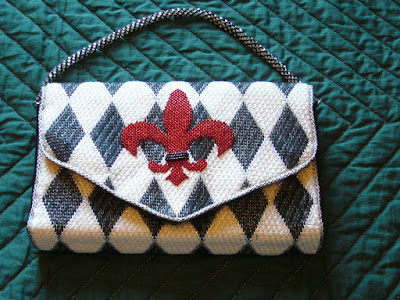Still in New Orleans, I took three classes.
The first was "Dynamics of Teaching", led by Val McAleenan. Unsurprisingly it was about teaching Needlepoint. I'm not sure that I will ever teach embroidery in a formal way, but I thought it would be interesting to hear a teacher talk about the inter-relationships that happen in an embroidery class. As someone who has in the past trained people in basic IT skills and IT Security (and who tries to be a good boy in class), I was aware of the different types of students found in the business environment, and was, in a way not surprised to find that all of the same types attend embroidery classes. The big difference is that in a business environment the attendee has generally been sent, while in a Needlepoint class, the attendee has chosen to be there and has paid good $$$ for the privilege, so the way you treat the difficult or disruptive has to be, if not different, perhaps a bit more patient.
I've done a little ad-hoc teaching since then, and I always let my student or students work at their own pace. You can't do this is a class of more than four or five, so you, as the teacher, have to be prepared to sit after class with the slower stitcher to make sure they know what they're doing and how to do it. I don't think there can be anything worse for a student than to be sitting without an idea of what to do.
At one point it brought back to my memory my first French lesson. As usual, having returned from holiday in Singapore, I ended up in the school hospital for a week. Long story, put briefly, I had an allergy to the school issue vests which made me come out in spots, which the school assumed was some evil foreign disease I had picked up in the mysterious East, so I was hauled off to the school hospital for two weeks. Having been released, one of my first classes was French, of which I had absolutely no knowledge. The teacher (an ex-Polish cavalryman of WWII vintage) immediately rounded on this new face and asked me a question - in French. I had no idea. I shrugged, said I didn't understand, he got angry, he shouted at me. It took me some moments to understand that he was actually speaking English - yes, his English accent was like something out of a bad comedy movie. I became, in his eyes, the class failure, and from then on I dreaded French.
Lesson? Take care how you speak to students. A few badly chosen words can destroy confidence in seconds.
I hated French from that moment, but I'd like to put it on record that I had great respect for 'The Wee Pole' as he was nicknamed, as a man. You may have heard the story of Polish Cavalry charging German tanks in 1939. He was one of those cavalrymen. You can't not respect that.
Well, that was a long story for a one day class. My second class was with Janet Zickler Casey, and was called "Let The Good Times Roll!" (Or "Laissez Les Bon Temps Rouler!" - which I still pronounce in a Polish-French accent.)
As you can see, it's a handbag. The Fleur-de-lis is beaded, as is the handle. The class included teaching us how to make the beaded handle as well as how to stitch the body of the handbag. What drew me to this class was the teacher, whom I had already met a number of times. Jane-Beth had taken a few classes with her and raved about how good she was and how much fun her classes were.
On the first day of class, yes, me in my kilt as usual, the lady next to me asked, in a friendly manner, why a man would take a class to make a beaded handbag. I couldn't resist it, "a boy just can't have enough handbags," I replied. That broke the ice as the rest of the class realised I was just as nuts about Needlepoint as they were.
It was indeed a fun class, with lots of discussion around colour choices and personalising the design. There was lots of laughter, lots of stitching, and lots of discussion about colour, stitches and much else. You'll meet the handbag again.
The third class I attended in New Orleans was "Sisters" by Nancy Cucci. Obviously NOLA was my 'beading' year.
I chose this class for a number of reasons. I loved the design, particularly the repetition of the same stitches, but not in the same order, in the large squares. To me it made the point that in a family the siblings may all have started with the same genetic material, but we all become distinct individuals. I liked the colour selection too, the dark balancing the light, the overlaps of the squares slipping into companionship rather than opposition and the background pulling them all together like the members of a single household.
I had been wary of beads for a long time, but I wanted to take a class with Nancy. She was a great teacher, very relaxed and and yet attentive to every student. Thanks to her I am no longer afraid of small shiny things. It was great fun and I really enjoyed every minute I spent working on "Sisters". I still haven't decided which Brother, I have three, deserves this.
Sisters measures 5½ x 10½ inches and is worked on 18 count canvas. It took me 75 hours to stitch.
If you like the look of "Sisters", you can find another version in Melita's blog, Melitastitches4fun. There's a link at the top of the page.









